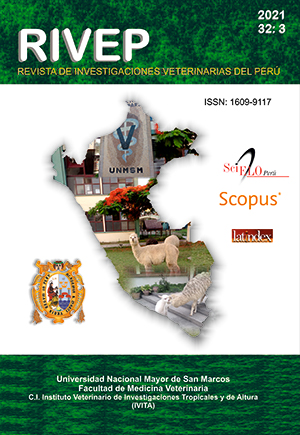The problem of stray dogs and control plans at the local government level in Lima, Peru
DOI:
https://doi.org/10.15381/rivep.v32i3.20393Keywords:
bites, stray dogs, public health, zoonosisAbstract
The aim of this study was to determine the importance of stray dogs by the local governments of Metropolitan Lima and to identify the proposed control plans. The descriptive study involved 32 of the 43 municipalities of Metropolitan Lima that agreed to participate. The survey model carried out by the OIE regarding the control of dog population was used. In general, 90.6% (29) considered stray dogs a problem in their district, uncontrolled reproduction being the most serious problem. In addition, 58.6% (17) indicated that the municipality did not have a plan to address the problem, while 31% (9) had a plan and 10.4% (3) did not but were carrying out activities to address it. Surgical methods (spaying and neutering) were the most mentioned by the authorities to try to control the stray dog population, while euthanasia was only mentioned for cases of terminal illness or aggressiveness. Regarding budget allocation, 59.4% (19) indicated that the municipality did not have specific budget for the veterinary public health area; likewise, the insufficient or non-existent budget (82.1%) and the lack of infrastructure for the development of activities (71.4%) were the main limitations of the municipality to address the problem of stray dogs. The information obtained can be used to raise awareness about the impact of stray dogs on public health and assess the need to develop control plans that are adjusted to the needs and limitations of each district.
Downloads
Downloads
Published
Issue
Section
License
Copyright (c) 2021 Sofía Cáceda, Daphne León, Néstor Falcón

This work is licensed under a Creative Commons Attribution 4.0 International License.
AUTHORS RETAIN THEIR RIGHTS:
a. Authors retain their trade mark rights and patent, and also on any process or procedure described in the article.
b. Authors retain their right to share, copy, distribute, perform and publicly communicate their article (eg, to place their article in an institutional repository or publish it in a book), with an acknowledgment of its initial publication in the Revista de Investigaciones Veterinarias del Perú (RIVEP).
c. Authors retain theirs right to make a subsequent publication of their work, to use the article or any part thereof (eg a compilation of his papers, lecture notes, thesis, or a book), always indicating the source of publication (the originator of the work, journal, volume, number and date).










